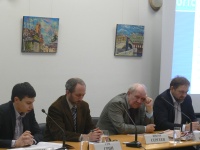Registration
You will receive an email confirming your registration.
IMGXYZ3018IMGZYXAnalysts at U.S. investment bank Goldman Sachs created the acronym BRIC (Brazil, Russia, India, and China) in 2001. Originally, it was aimed at promoting investment opportunities in emerging markets. Since then, however, the acronym has taken on new meaning and, in many ways, gone far beyond its initial intent. Kirill Koktysh, Viktor Sergeyev, and Kirill Petrov of the Moscow State Institute of International Relations are among the authors of a report analyzing this issue, entitled “BRIC: Political Reality in the Post-Crisis World? New Opportunities for Russia.” They spoke at the Carnegie Moscow Center. Carnegie’s Sam Greene moderated.
Original Concept of BRIC
As Petrov noted, the BRIC concept was originally built around the idea of tying Brazil, Russia, India, and China together as a single group of fast-growing economies, with high GDP growth characterized by rapid job creation, stock market growth, and technological progress. Goldman Sachs promoted the view that the BRIC countries would enjoy an increasingly important role in the global economy, while the G7—the group of the world’s richest countries—would lose its economic leadership.
Changes in the BRIC Concept
The media started using the BRIC term frequently in 2008-2009, when the global financial crisis took hold. But the BRIC countries themselves had—and continue to have—differing interpretations of the acronym’s meaning and use.
- Russia and Brazil: Before the crisis, commentators in these countries used the acronym without any substantial changing of its original meaning. After the crisis, experts in Russia and Brazil began looking at BRIC as a group of countries able to influence the decisions needed to stabilize the global financial system. In these countries, BRIC has come to be considered one of the centers of a “multipolar world order.”
- India: BRIC was seldom mentioned in India before 2008, but that changed after the crisis began. India is confident it will be one of the most important markets (according to the basic premise of the BRIC concept as formulated by Goldman Sachs), and India’s experts are now trying to figure out how the country can measure up to its new role. As Koktysh noted, the idea of BRIC has legitimized India’s isolationist tendencies: BRIC has interest for India as a political entity in which India sees itself as “tomorrow’s leader,” able to cope on its own with changing external circumstances and compensate for external difficulties by developing its internal market.
- China: Only economic experts talked about BRIC in China before the crisis, but afterward, the term began taking on a new—completely different to the initial—meaning, Koktysh explained. Discussions began in 2009 about the prospect of unifying BRIC as a political bloc, pursuing internal integration, and building greater mutual confidence among the BRIC countries. China outlined two foreign policy aims for BRIC: obtaining a share of control over global finances and fighting protectionism. China’s current interpretation of the BRIC concept is aimed above all at the United States. China appears to want to use the idea of BRIC in negotiations with the United States—as possible small coin in the game or as an instrument that can help China pursue its own goals.
BRIC has clearly taken on a political dimension over the last few years, Petrov noted. The BRIC countries have started using the BRIC concept to pursue their own political ambitions. BRIC continues to change; increasingly, people are referring to BRICS: BRIC plus South Africa. (This country had received a formal invitation to join BRIC from China in 2010 and attended the BRICS summit as a member for the first time in April 2011 in Sanya, Hainan province, China.)
Inside BRIC
In spite of the acronym, the political and economic interests of BRIC countries are not necessarily aligned. However, Sergeyev noted that in comparison with external problems, BRIC’s internal contradictions are minor. This gives hope to the idea that relations among these countries will continue to develop well in the future.
